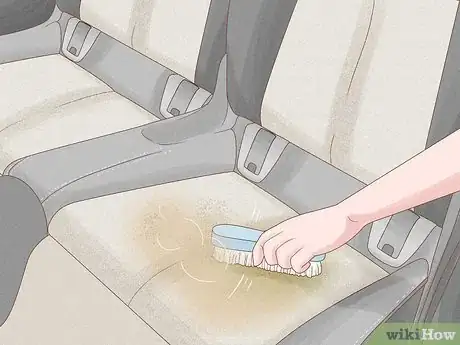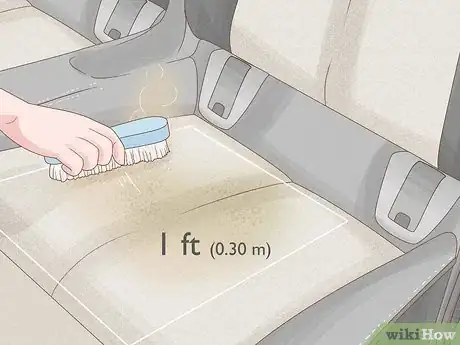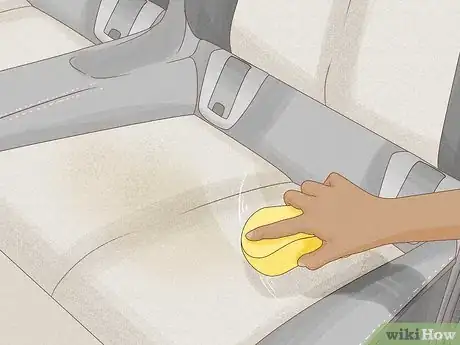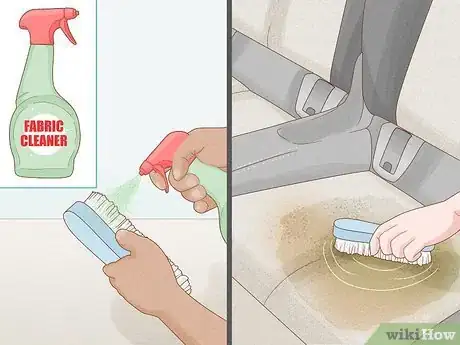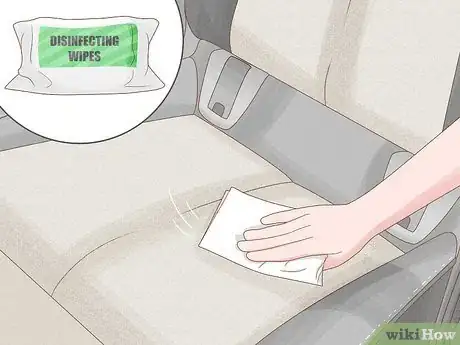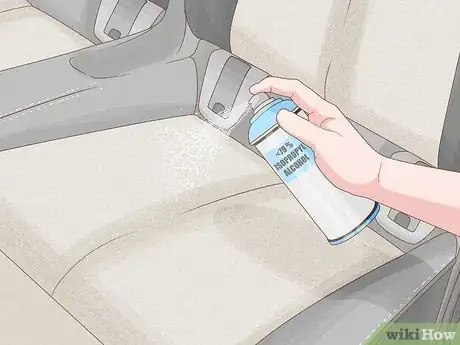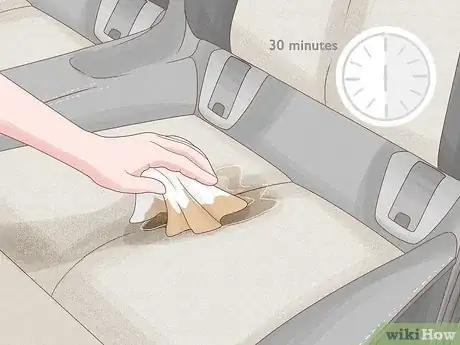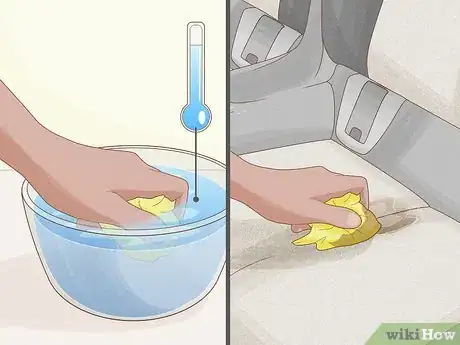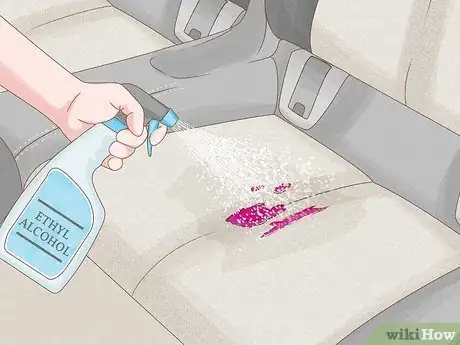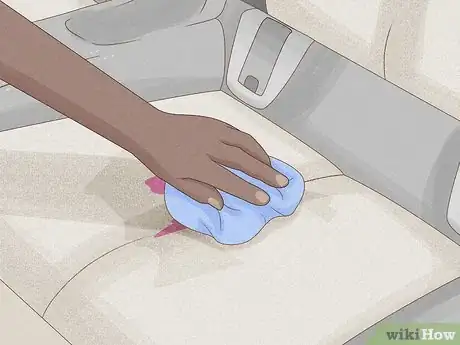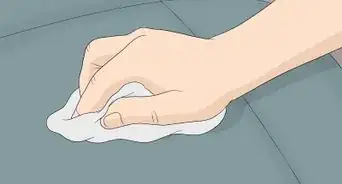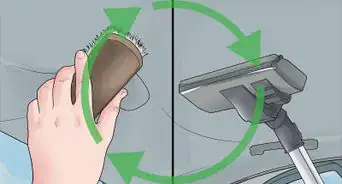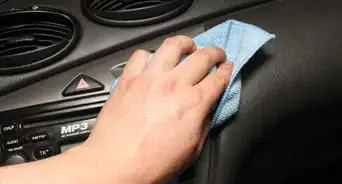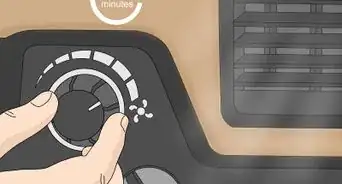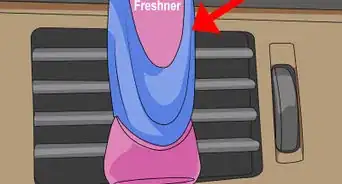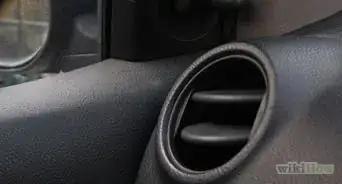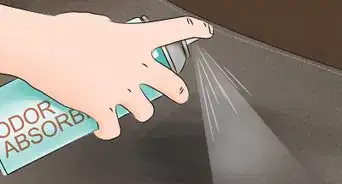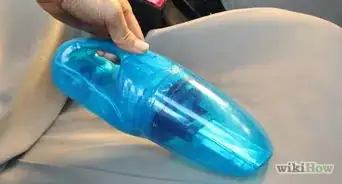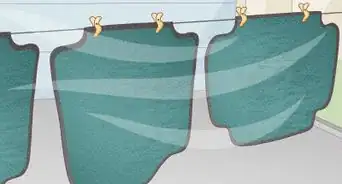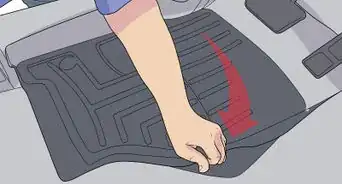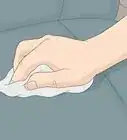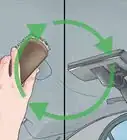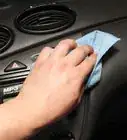This article was co-authored by wikiHow Staff. Our trained team of editors and researchers validate articles for accuracy and comprehensiveness. wikiHow's Content Management Team carefully monitors the work from our editorial staff to ensure that each article is backed by trusted research and meets our high quality standards.
There are 10 references cited in this article, which can be found at the bottom of the page.
This article has been viewed 12,495 times.
Learn more...
Alcantara is a high-end synthetic textile commonly used to lend lush detailing accents to automobile interiors, consumer electronics, clothing, and accessories. The fabric is prized for its luxurious, ultra-soft look and feel, both of which are almost identical to suede. Because of the similarities between the two materials, cleaning Alcantara isn’t much different from cleaning suede, and in most cases only requires a soft-bristled brush and a little bit of water.
Steps
Removing Minor Dust and Dirt
-
1Brush the surface with a soft-bristled brush to loosen dust and debris. Sweep the brush over the surface using quick, gentle strokes. Make each of your strokes in a single direction rather than whisking the brush back and forth to minimize the risk of compressing or distressing the nap.[1]
- A high-quality auto detailing brush or natural boar- or horsehair brush will be ideal for this task.[2]
- You can also do your dusting with a soft, dry, non-shedding cloth or towel if you don’t have a suitable brush on hand.
- Get in the habit of giving your Alcantara surface a good brushing every 1-2 weeks, or more often as needed.
Warning: Try not to be too forceful here. Doing so could crush the nap, ruining its rich texture and appearance.
-
2Work in 1 ft (0.30 m) sections to avoid harming the fabric. When cleaning car seats, electronics or appliance covers, or other broad surfaces, always start with a small patch near one corner or outlying edge. Focus on ridding your starting section of all visible dust, debris, and unwanted substances before moving on to the neighboring section.[3]
- Patience is a virtue. If you get in a rush, you could end up damaging or oversaturating the material’s synthetic nap. At best, this will detract from its beauty. At worst, it could lead to premature deterioration.
Advertisement -
3Wipe the Alcantara with a damp cloth or sponge to lift away trapped dirt. Wet your cloth or sponge with cool or lukewarm water, then wring out the excess liquid so that it’s only slightly moist. Run it over the surface lightly using linear strokes. If you need to make multiple passes, be sure to do them in the same direction.[4]
- Feather-light terrycloth towels are perfectly suited for temperamental fabrics like Alcantara, but a microfiber cloth will work almost just as well.
- As you did during your initial brushing, take care not to apply too much pressure, especially if you’re using water or fabric cleaner fluid.[5]
Deep-Cleaning and Disinfecting
-
1Renew heavily soiled Alcantara with an approved fabric cleaner. Spritz a conservative amount of the solution onto the tip of your brush and work it into the problem area with tight circular motions. Together, the delicate lather and repetitive massaging action will coax out deep-set dirt and grime in just a few seconds.[6]
- The manufacturers of Alcantara only recommend a small number of cleaning products for use on the material. A complete list of these products can be found on the company’s official website.[7]
- A specialty fabric cleaner can be useful for taking care of messes that water alone just isn’t strong enough to handle.
- It shouldn’t typically be necessary to use cleaning products on your Alcantara surface any more often than about once every few months.
-
2Vacuum the freshly-cleaned surface to wick up lingering moisture. Fit a portable shop vacuum with a slender crevice attachment, switch it on, and move the nozzle over the entire surface one small strip at a time. The suction will collect any residual fabric cleaning fluid that’s been left behind while also lifting and straightening the compressed nap.[8]
- If you don’t have a vacuum or an appropriate detailing attachment, give your surface one last thorough brushing to help reorder the nap.
-
3Wipe Alcantara with disinfecting wipes to eliminate unseen germs. Take a pre-moistened wipe, press it lightly into your surface, and glide it back and forth. For best results, aim to thoroughly dampen the material without saturating it. Ideally, it should remain damp for a minimum of 3-5 minutes.[9]
- Make sure you hit each and every part of the surface. Otherwise it’s possible for the remaining bacteria to multiply and spread.[10]
- Most brand-name disinfecting wipes are formulated to kill up to 99.99% of disease-causing viruses and bacteria on contact.
Tip: Public health officials now recommend disinfecting frequently-used surfaces at least once a day in order to slow the spread of COVID-19.
-
4Sanitize your surface with < 70% isopropyl alcohol if you can’t find wipes. Low-concentrations of isopropyl alcohol have also been designated as safe for use on Alcantara surfaces. Just spray or squeeze a small amount of alcohol onto a soft terrycloth towel or microfiber cloth and apply it to the surface the same way you would an ordinary disinfecting wipe.[11]
- Stay away from alcohol solutions with a purity greater than 70%. These could potentially break down the polyester-polyurethane fibers that Alcantara is woven from.
Treating Spills and Stains
-
1Deal with fresh spills within 30 minutes to prevent them from setting. Time is of the essence when you’re faced with potential stains on Alcantara. If you wait too long to address a spill, the offending substance can seep down into the fabric’s raised nap, where it will then dry and become much tougher to get rid of.[12]
- Don’t worry if you don’t discover a spill until later—all is not lost, as long as you take the proper action immediately.
-
2Dab water-soluble stains with a soft cloth dampened with cold water. This includes things like food, condiments, coffee, tea, alcohol, and most hair and hygiene products. Blot the stain from the outer edges inward to keep from spreading it any further. Try to absorb as much of the mess as you can without being unnecessarily rough on the fabric.[13]
- Avoid rubbing the stain in an effort to erase it. This too could inadvertently cause it to expand.
- Never use warm or hot water on bodily fluids like blood, urine, or feces. Exposing these sorts of substances to elevated temperatures will only cause them to set faster, and, in some cases, permanently.[14]
Tip: Pre-treat food and beverage messes with lemon juice, or mix a few drops in with the water you use to dampen your cloth. The acetic acid contained in the juice of the fruit will help to eat away at stubborn stains naturally.[15]
-
3Use ethyl alcohol to break up stains that won’t dissolve in water. For h20-resistant items like cosmetics, polishes, perfumes, oils, grease, and grass, wet the corner of your cloth with pure ethyl alcohol and press it into the stain gently and repeatedly. It should start to come up once the alcohol has had a few moments to work its magic.[16]
- After applying ethyl alcohol to your surface, go back over it with a separate cloth dampened with clean water to “rinse” it.
- Note that only ethyl (grain) alcohol is officially approved for use on Alcantara, not other varieties like isopropyl or methyl.
-
4Wipe the surface dry with soft, clean cloth. Once you’ve seen to the worst of the stain, grab a fresh cloth or towel and run it over the area you just cleaned to remove any leftover traces of water, lemon juice, or alcohol. Then, allow the surface to sit undisturbed for 1-2 hours so that it can air dry the rest of the way. With any luck, it will look as good as new when you’re finished![17]
- If possible, hold off on touching the material until it’s had time to dry completely.
- Intense heat can easily melt the tiny plastic fibers that comprise the fabric, so don't attempt to speed up the drying process with a space heat, hair dryer, heat gun or any other heat source.
Warnings
- Be careful with food, drinks, and makeup or personal hygiene products around your Alcantara surface. These sorts of substances are generally more difficult to remove than the occasional sprinkling of dust and dirt.⧼thumbs_response⧽
- While Alcantara is often praised for being more durable, resilient, and easily cleaned than suede, subjecting it to rough treatment or large quantities of moisture could damage it beyond repair.⧼thumbs_response⧽
Things You’ll Need
Removing Minor Dust and Dirt
- Soft-bristled detailing brush
- Soft, non-shedding cloth or towel
- Water
- Soft sponge (optional)
Deep-Cleaning and Disinfecting
- Approved fabric cleaning product
- Soft-bristled detailing brush
- Portable shop vacuum
- Crevice attachment
- Disinfecting wipes
- < 70% isopropyl alcohol solution (optional)
- Soft, non-shedding cloth or towel (optional)
Treating Spills and Stains
- Soft, non-shedding cloths or towels
- Cold or lukewarm water
- Lemon juice (optional)
- Pure ethyl alcohol (optional)
References
- ↑ https://teslamotorsclub.com/tmc/threads/how-to-properly-clean-and-maintain-suede-and-alcantara.21718/
- ↑ https://www.carbibles.com/car-detailing-brushes/
- ↑ https://www.theartofcleanliness.com/automotive/cleaning-maintaining-alcantara-suede-interior/
- ↑ https://www.alcantara.com/wp-content/uploads/2020/03/Instructions-for-maintenance-of-alcantara-material.pdf
- ↑ https://www.theartofcleanliness.com/automotive/cleaning-maintaining-alcantara-suede-interior/
- ↑ https://www.youtube.com/watch?v=PM-FbFIBoCs&feature=youtu.be&t=53
- ↑ https://www.alcantara.com/
- ↑ https://www.youtube.com/watch?v=PM-FbFIBoCs&feature=youtu.be&t=91
- ↑ https://support.microsoft.com/en-us/help/4023504/surface-clean-and-care-for-your-surface
- ↑ https://www.today.com/home/there-s-right-wrong-way-use-cleaning-wipes-apparently-t154581
- ↑ https://support.microsoft.com/en-us/help/4023504/surface-clean-and-care-for-your-surface
- ↑ https://www.alcantara.com/wp-content/uploads/2020/03/Instructions-for-maintenance-of-alcantara-material.pdf
- ↑ https://www.theartofcleanliness.com/automotive/cleaning-maintaining-alcantara-suede-interior/
- ↑ https://www.goodhousekeeping.com/uk/house-and-home/household-advice/a678570/stain-mistakes-not-to-make/
- ↑ https://teslamotorsclub.com/tmc/threads/how-to-properly-clean-and-maintain-suede-and-alcantara.21718/
- ↑ https://www.alcantara.com/wp-content/uploads/2020/03/Instructions-for-maintenance-of-alcantara-material.pdf
- ↑ https://www.theartofcleanliness.com/automotive/cleaning-maintaining-alcantara-suede-interior/
